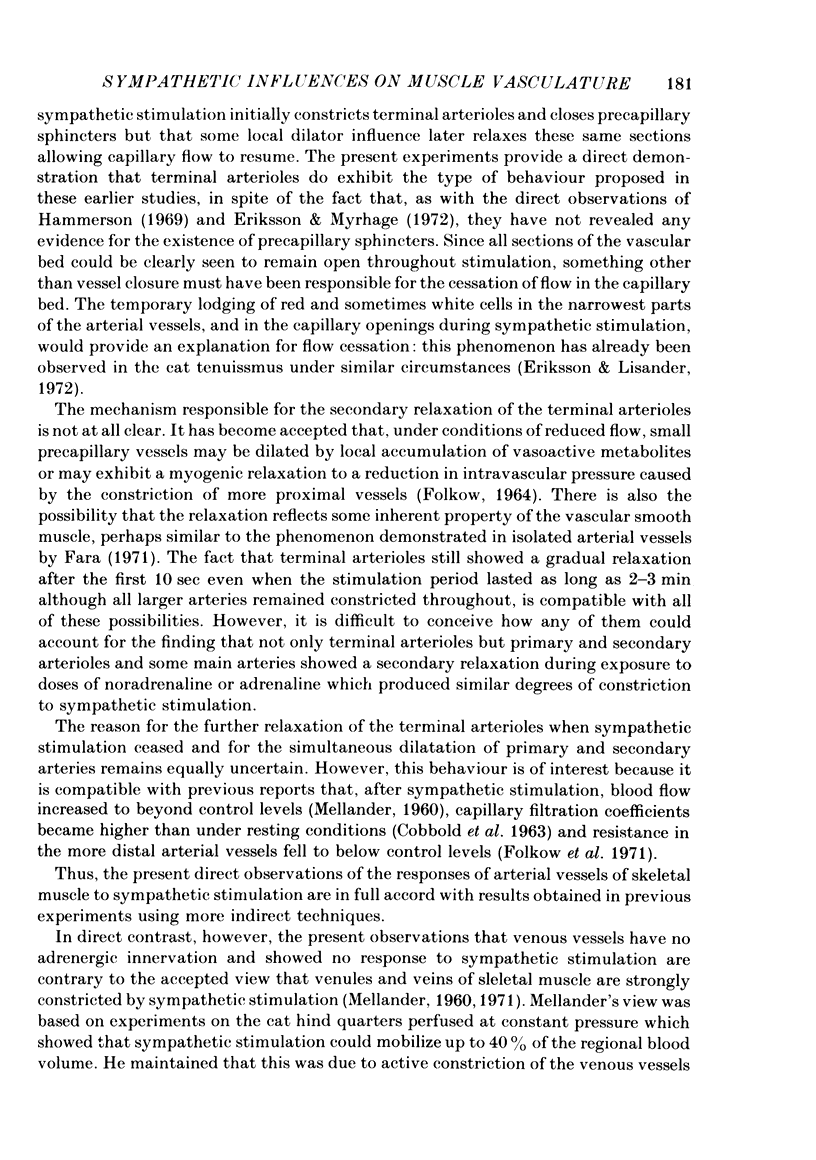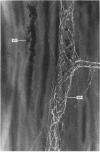Abstract
1. Direct observations have been made on the responses of individual vessels of the microcirculation of rat spinotrapezius muscle to stimulation of the sympathetic paravascular nerve fibres and to topically applied catecholamines.
2. All arteries and arterioles were constricted by sympathetic stimulation, the maximum response occurring at a stimulus frequency of 8-10 Hz. Primary and secondary arterioles (13-50 μm internal diameter) showed the greatest percentage change in diameter and remained constricted throughout the 1 min stimulation period whilst terminal arterioles (7-13 μm internal diameter) constricted initially but then returned towards their control diameter before the stimulus ceased.
3. By contrast the venules and veins showed no response to sympathetic stimulation.
4. In accord with these observations, fluorescence histochemical studies revealed a network of noradrenergic nerve fibres on all arterial vessels but showed no innervation of any venous vessels.
5. Topically applied noradrenaline or adrenaline (10-10-10-8 g/ml.) dilated the majority of arteries and arterioles while higher concentrations of either agent produced dose-dependent constrictor responses. In addition, many venules dilated in response to adrenaline (10-9 g/ml.) while others constricted, but concentrations of either noradrenaline or adrenaline greater than 10-8 g/ml. produced dose-dependent constriction of all venules and veins.
6. The behaviour of the more proximal and more distal arterioles during sympathetic stimulation is in accord respectively with the changes in muscle vascular resistance and in capillary surface area recorded in previous studies during sympathetic stimulation.
7. The observation that venous vessels are not influenced by sympathetic nerve fibres contrasts with the established view that venous vessels of skeletal muscle are strongly constricted during sympathetic stimulation. However, reappraisal of the evidence used to support this view indicates that such results may have been misinterpreted, while other available evidence supports the proposal that the present findings may be representative of skeletal muscle vasculature in general.
Full text
PDF



















Images in this article
Selected References
These references are in PubMed. This may not be the complete list of references from this article.
- Abboud F. M., Eckstein J. W. Comparative changes in segmental vascular resistance in response to nerve stimulation and to norepinephrine. Circ Res. 1966 Mar;18(3):263–277. doi: 10.1161/01.res.18.3.263. [DOI] [PubMed] [Google Scholar]
- BAUM T., HOSKO M. J., Jr RESPONSE OF RESISTANCE AND CAPACITANCE VESSELS TO CENTRAL NERVOUS SYSTEM STIMULATION. Am J Physiol. 1965 Jul;209:236–242. doi: 10.1152/ajplegacy.1965.209.1.236. [DOI] [PubMed] [Google Scholar]
- Bolme P., Novotný J., Uvnäs B., Wright P. G. Species distribution of sympathetic cholinergic vasodilator nerves in skeletal muscle. Acta Physiol Scand. 1970 Jan;78(1):60–64. doi: 10.1111/j.1748-1716.1970.tb04639.x. [DOI] [PubMed] [Google Scholar]
- Browse N. L., Lorenz R. R., Shepherd J. T. Response of capacity and resistance vessels of dog's limb to sympathetic nerve stimulation. Am J Physiol. 1966 Jan;210(1):95–102. doi: 10.1152/ajplegacy.1966.210.1.95. [DOI] [PubMed] [Google Scholar]
- COBBOLD A., FOLKOW B., KJELLMER I., MELLANDER S. Nervous and local chemical control of pre-capillary sphincters in skeletal muscle as measured by changes in filtration coefficient. Acta Physiol Scand. 1963 Jan-Feb;57:180–192. doi: 10.1111/j.1748-1716.1963.tb02584.x. [DOI] [PubMed] [Google Scholar]
- Coote J. H., Hilton S. M., Zbrozyna A. W. The ponto-medullary area integrating the defence reaction in the cat and its influence on muscle blood flow. J Physiol. 1973 Mar;229(2):257–274. doi: 10.1113/jphysiol.1973.sp010137. [DOI] [PMC free article] [PubMed] [Google Scholar]
- De La Lande I. S., Waterson J. G. Site of action of cocaine on the perfused artery. Nature. 1967 Apr 15;214(5085):313–314. doi: 10.1038/214313a0. [DOI] [PubMed] [Google Scholar]
- Eriksson E., Lisander B. Changes in precapillary resistance in skeletal muscle vessels studied by intravital microscopy. Acta Physiol Scand. 1972 Mar;84(3):295–305. doi: 10.1111/j.1748-1716.1972.tb05181.x. [DOI] [PubMed] [Google Scholar]
- Eriksson E., Myrhage R. Microvascular dimensions and blood flow in skeletal muscle. Acta Physiol Scand. 1972 Oct;86(2):211–222. doi: 10.1111/j.1748-1716.1972.tb05327.x. [DOI] [PubMed] [Google Scholar]
- FUXE K., SEDVALL G. THE DISTRIBUTION OF ADRENERGIC NERVE FIBRES TO THE BLOOD VESSELS IN SKELETAL MUSCLE. Acta Physiol Scand. 1965 May-Jun;64:75–86. doi: 10.1111/j.1748-1716.1965.tb04155.x. [DOI] [PubMed] [Google Scholar]
- Fara J. W. Escape from tension induced by noradrenaline or electrical stimulation in isolated mesenteric arteries. Br J Pharmacol. 1971 Dec;43(4):865–867. doi: 10.1111/j.1476-5381.1971.tb07223.x. [DOI] [PMC free article] [PubMed] [Google Scholar]
- Folkow B., Sonnenschein R. R., Wright D. L. Loci of neurogenic and metabolic effects on precapillary vessels of skeletal muscle. Acta Physiol Scand. 1971 Apr;81(4):459–471. doi: 10.1111/j.1748-1716.1971.tb04924.x. [DOI] [PubMed] [Google Scholar]
- Furness J. B., Malmfors T. Aspects of the arrangement of the adrenergic innervation in guinea-pig as revealed by the fluorescence histochemical method applied to stretched, air-dried preparations. Histochemie. 1971;25(4):297–309. doi: 10.1007/BF00278223. [DOI] [PubMed] [Google Scholar]
- GRANT R., LINDGREN P., ROSEN A., UVNAS B. The release of catechols from the adrenal medulla on activation of the sympathetic vasodilator nerves to the skeletal muscles in the cat by hypothalamic stimulation. Acta Physiol Scand. 1958 Aug 25;43(2):135–154. doi: 10.1111/j.1748-1716.1958.tb01583.x. [DOI] [PubMed] [Google Scholar]
- Gray S. D. Effect of hypertonicity on vascular dimensions in skeletal muscle. Microvasc Res. 1971 Jan;3(1):117–124. doi: 10.1016/0026-2862(71)90016-1. [DOI] [PubMed] [Google Scholar]
- Gray S. D. Responsiveness of the terminal vascular bed in fast and slow skeletal muscles to -adrenergic stimulation. Angiologica. 1971;8(6):285–296. doi: 10.1159/000157902. [DOI] [PubMed] [Google Scholar]
- Hadjiminas J., Oberg B. Effects of carotid baroreceptor reflexes on venous tone in skeletal muscle and intestine of the cat. Acta Physiol Scand. 1968 Apr;72(4):518–532. doi: 10.1111/j.1748-1716.1968.tb03876.x. [DOI] [PubMed] [Google Scholar]
- Lesh T. A., Rothe C. F. Sympathetic and hemodynamic effects on capacitance vessels in dog skeletal muscle. Am J Physiol. 1969 Sep;217(3):819–827. doi: 10.1152/ajplegacy.1969.217.3.819. [DOI] [PubMed] [Google Scholar]
- MELLANDER S. Comparative studies on the adrenergic neuro-hormonal control of resistance and capacitance blood vessels in the cat. Acta Physiol Scand Suppl. 1960;50(176):1–86. [PubMed] [Google Scholar]
- Marshall J. M. Proceedings: The influence of the sympathetic nervous system on the microcirculation of skeletal muscle. J Physiol. 1976 Jun;258(2):118P–119P. [PubMed] [Google Scholar]
- Marshall J. M. The effect of uptake by adrenergic nerve terminals on the sensitivity of arterial vessels to topically applied noradrenaline. Br J Pharmacol. 1977 Nov;61(3):429–432. doi: 10.1111/j.1476-5381.1977.tb08436.x. [DOI] [PMC free article] [PubMed] [Google Scholar]
- Mayer H. E., Abboud F. M., Ballard D. R., Eckstein J. W. Catecholamines in arteries and veins of the foreleg of the dog. Circ Res. 1968 Nov;23(5):653–661. doi: 10.1161/01.res.23.5.653. [DOI] [PubMed] [Google Scholar]
- Mellander S. Interaction of local and nervous factors in vascular control. Angiologica. 1971;8(3-5):187–201. doi: 10.1159/000157894. [DOI] [PubMed] [Google Scholar]
- RENKIN E. M., ROSELL S. The influence of sympathetic adrenergic vasoconstrictor nerves on transport of diffusible solutes from blood to tissues in skeletal muscle. Acta Physiol Scand. 1962 Mar-Apr;54:223–240. doi: 10.1111/j.1748-1716.1962.tb02348.x. [DOI] [PubMed] [Google Scholar]
- Richardson D. R., Zweifach B. W. Pressure relationships in the macro- and microcirculation of the mesentery. Microvasc Res. 1970 Oct;2(4):474–488. doi: 10.1016/0026-2862(70)90040-3. [DOI] [PubMed] [Google Scholar]
- Rodigas P., Cession-Fossion A. Evolution de la catécholaminémie, lors de la saignée, chez le rat éveillé. C R Seances Soc Biol Fil. 1972;166(4):747–749. [PubMed] [Google Scholar]
- Stingl J. Arrangement of the vascular bed in the skeletal muscles of the rabbit. Folia Morphol (Praha) 1969;17(3):257–264. [PubMed] [Google Scholar]
- Vanhoutte P. M. Inhibition by acetylcholine of adrenergic neurotransmission in vascular smooth muscle. Circ Res. 1974 Mar;34(3):317–326. doi: 10.1161/01.res.34.3.317. [DOI] [PubMed] [Google Scholar]
- Webb-Peploe M. M., Shepherd J. T. Response of large hindlimb veins of the dog to sympathetic nerve stimulation. Am J Physiol. 1968 Aug;215(2):299–307. doi: 10.1152/ajplegacy.1968.215.2.299. [DOI] [PubMed] [Google Scholar]
- ZWEIFACH B. W., METZ D. B. Selective distribution of blood through the terminal vascular bed of mesenteric structures and skeletal muscle. Angiology. 1955 Aug;6(4):282–290. doi: 10.1177/000331975500600402. [DOI] [PubMed] [Google Scholar]
- Zimmerman B. G. Influence of sympathetic stimulation on segmental vascular resistance before and after adrenergic neuronal blockade. Arch Int Pharmacodyn Ther. 1966 Mar;160(1):66–82. [PubMed] [Google Scholar]




